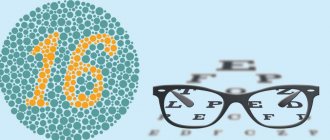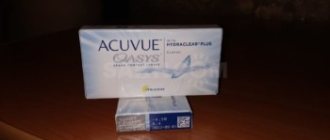When a person first encounters wearing lenses, he may make a common mistake - putting them on inside out. Of course, if you put the contact lens on the wrong side, nothing extremely dangerous will happen, but you will immediately feel discomfort. After removal, the devices are thoroughly washed in a multi-purpose solution and put back on with the correct side. To prevent such an incident from happening, find out in advance how to determine the right side of the lenses. This will be discussed.
Share
Tweet
Share
Cool
Send
Types of contact lenses
Contact lenses are classified in different ways.
According to the material of manufacture:
- Hard contact lenses are gas-permeable and gas-tight, last almost unlimitedly and are more expensive. More durable, low risk of damage when putting on
- Soft - used more often than others. They are divided into hydrogel and silicone hydrogel. There are one-day and long-term use up to 6 months. Among the disadvantages are difficulties in use, without skill they can tear.
- Scleral - due to the large diameter, they are attached not to the cornea, but to the sclera. They are used for sensitive corneas. Due to its large size, a special suction cup is used to attach it to the eye.
Depending on the wearing mode, optical lenses are:
- daytime - they are put on during the day and taken off at night;
- flexible – you can sometimes sleep with them, 1 to 2 times;
- prolonged – these optical devices can be worn without taking them off for several days in a row;
- Continuous wear lenses - you can wear them for a month without removing them.
Optical devices are divided into the following types depending on the period of their replacement:
- Traditional - they last from 6 months to 1 year. Available in glass bottles.
- Scheduled replacement contact lenses are produced in blisters, which ensure the safety and sterility of the material. They come in daily, weekly, two-week, monthly and three-month replacements.
By purpose, optical instruments are classified as follows:
- Optical – designed to correct visual impairment.
- Spherical – used for farsightedness or myopia.
- Toric – corrects astigmatism.
- Multifocal – prescribed for presbyopia.
- Cosmetic - capable of changing eye color or adding brightness to your own shade.
Long-term wear lenses require careful care. After all, they are not thrown away after the first use, like disposable products. A special solution is needed that can clean and disinfect CL.
How to put on lenses for a beginner
Contact lenses are medical devices, so they must be put on the eyes in compliance with all instructions and sequence:
- Hands are washed first. This is a must. Otherwise, there is a risk of dirt and infection. Choose neutral or hypoallergenic soap. After soaping, rinse your hands thoroughly in running water. As a last resort, use a disinfectant.
- When drying your hands, do not use a towel with lint so that its particles do not get into the mucous membranes of your eyes.
- Remove lenses from container or packaging. Make sure they are washed and moisturized first. To remove lenses, you can use special silicone tweezers. It will be easier for them to pick up the product and place it on the pad of their finger.
- To avoid confusion between the left and right products, always start the procedure with the same eye. Don't think that they have no differences. They have different diopters, just like the eyes do. But it happens that the diopters are the same, then there is no difference in the choice of the right and left lenses.
- Place a transparent cup on your palm and drop a little solution onto it.
- Place the product on your index finger so that it is located in the center of the pad. The lens is aligned correctly if its edges face up in a bowl shape. If the lens is turned downwards, you will see letters on it.
- With your free hand and fingers, lift the upper eyelid, and with your working hand, lower the lower eyelid.
- At this time, the lens is placed on the cornea. To avoid triggering the corneal reflex, look up or to the side. After applying the product to the eye, it should be pressed lightly.
- Lower your eyelid, then blink to fix the lens. You can't rub your eyes.
- Do not forget to close the bottle with the solution, pour out the water from the container and let it dry for 10 minutes. After which it can be closed.
Use of scleral lenses
Unlike standard corneal lenses, scleral lenses cover not only the center of the eye, but also its white (sclera). They rest on a large area and go under the eyelids, so they are less likely to cause discomfort.
Scleral products can be soft or hard.
- The first ones are used to create a theatrical effect: filling the protein with one color or pattern.
- The latter are prescribed for complex ophthalmological diseases: keratoconus, neutrophic inflammation of the ocular membrane, severe age-related farsightedness, etc. They can also be used to strengthen the cornea in case of complications after transplantation.
Full scleral lenses measure up to 24 mm and therefore require careful examination of the cornea. At the initial stage of keratoconus and the absence of severe dryness, lighter overlays are prescribed. Their diameter is about 9 mm.
Scleral lenses provide impressive visual effects.
Safety precautions
Despite their comfort, scleral products are considered less safe, so when wearing you must strictly follow safety precautions:
- do not wear for more than 6 hours;
- use together with the drug Artificial tear;
- be regularly examined by an ophthalmologist;
- If pain, burning, swelling of the conjunctiva and other symptoms occur, immediately remove the product and consult your doctor.
Before wearing scleral lenses, you should consult an ophthalmologist. This rule also applies if they are theatrical.
Donning process
Scleral pads are applied in stages:
- preparation and disinfection are carried out in the same way as for corneas;
- the lens is placed on the pads of 2-3 fingers, because when holding only one there is a high risk of falling out and inaccurate installation;
- Before installing the product, the eyelids are moved apart and fixed with two fingers of the second hand;
- the lens is inserted and centered;
- If the pad is in precise contact with the sclera, you can release the eyelids.
To correct the position, you can slightly pull down the lower eyelid and move the pad up and down. Gripping with a suction cup may be difficult due to the large size and weight of the product.
Removing the Lens
Removal of scleral and corneal lenses is carried out in accordance with one instruction:
- Wash and dry your hands.
- Direct your gaze towards the ceiling, slightly pull down the lower eyelid, exposing the edge of the optical pad.
- Grasp the bottom edge with your fingers. Pull it down parallel to the surface of the face to avoid irritation of the lower eyelid.
- Squeeze it lightly with two fingers in a horizontal direction, remove it, clean it, put it in a container. Close the container. For additional cleaning, you can shake the closed container.
- Repeat for the second eye.
The sclera is removed in the same way as regular lenses.
Determining the correct side of the lens
Everyone who wears lenses should be able to distinguish between the sides of these optical products. Otherwise, you will have to remove them from your eyes again, and this can be fraught with consequences. Therefore, methods for determining the sides of lenses should be considered.
Using inscriptions
You can find out whether the lens is inverted or not using the inscriptions on it. To do this, go to the light source and take a closer look at the product. Manufacturers often put their own laser markings on their products; they are also called “inversion indicators”. Using them, it is easy to identify which way the CL is turned. If the letters and numbers are easy to read, then the device can be safely attached to the cornea.
If the marking is readable in a mirrored position, it means the lens is turned the wrong way.
Similar manipulations can be carried out with the color of the lens; in the correct position, the lens shell has a peculiar tint - blue or green. If the optical device is turned inside out, there will be no color on the optical housing.
According to product shape
The shape of the lens also says a lot. If you place it on the pad of your finger, the shape of the product will resemble a bowl, or the letter “U”. The base will be convex and the edges will be directed upward. A lens turned inside out resembles a deep plate, but not a bowl. If you look closely at the product, it looks like the Latin letter “V”. In this case, its sidewalls will be compacted.
Taco method
This test is performed by gently squeezing the contact lens. It is necessary to slightly squeeze the product in a curved form between the thumb and forefinger in half. But at the same time, the edges of the lens must remain free. If the two parts easily touch each other, then the product has taken the correct shape. If the edges of the lens do not meet at one point, this may mean that the silicone optics are inside out.
Recommendations and rules
In fact, for many years there has been a list of clear rules, following which allows you to combine wearing contact lenses with the use of cosmetics, without compromising your health and comfort. And this list begins with the recommendation to wash your hands before any manipulation of contact lenses, including putting them on and removing them. It is best to use a mild soap or a product designed specifically to disinfect the hands of lens wearers. Then, even if particles of cosmetics accidentally get on your eyes, you will not feel any irritation. It is noteworthy that in most cases, soft contact lenses (SCLs) should be worn before applying makeup, and hard gas permeable lenses (HGP lenses) after applying it, including mascara. Contact lenses should be removed before makeup is removed from the face and eyes. As for makeup removal, it is done with special hypoallergenic makeup removers. Contact lens wearers also need to know how to apply makeup. For example, it is useful to remember that when wearing lenses, mascara is applied from the middle of the eyelashes. And if you start coloring eyelashes from their very base, this leads to blockage of the meibomian glands, which are located at the edges of the eyelids and secrete a secretion that lubricates the cornea, conjunctiva of the eye and the surface of contact lenses. Consequently, their blockage leads to discomfort and dry eyes.
It is helpful to refrain from using cosmetics to increase the volume of your eyelashes, as these types of products can flake off and get on the surface of the lenses. Also, do not use an eyeliner pencil to draw lines directly along the very edge of the eyelids. As mentioned above, this is the area where the meibomian glands are located, so clogging them with crayon leads to dry eye symptoms and paint particles getting into the tear film and onto the surface of the lenses. Therefore, it is better to draw the line just above the base of the upper eyelashes and just below the base of the lower eyelashes. To draw lines, it is useful to use cosmetics in the form of eye pencils, since gels and creams peel off easily after drying.
It is also worth considering that the paint from soft pencils peels off less than from hard pencils. You need to exercise caution and moderation when using cosmetics in the form of powder, be it face powder, eye shadow, blush, etc.
When applying such products, you should close your eyes. If possible, it is preferable to use cream as eyeshadow instead of powder. As for perfume and hairspray in the form of a spray, they should be applied before putting on contact lenses, since these products easily settle on their surface. But if the lenses are still on, then when spraying sprays it is best to close your eyes rather than simply try to get out of the cloud that has formed.
A summary of these rules and recommendations:
1. Wear SCLs before applying makeup, and LGP lenses after applying it.
2. Give preference to hypoallergenic cosmetics, especially those that are intended specifically for contact lens users
3. Prefer eye shadow in cream form (preferably water-based) rather than powder.
4. Use an eyeliner to draw lines just below the edge of the lower eyelid and just above the edge of the upper eyelid.
5. Do not use mascara intended to increase the volume of eyelashes, due to the high likelihood of it peeling off and getting into the eyes and lenses.
6. Do not use waterproof mascara as it is not easy to wash off with water and may stain your MCL.
7. When applying mascara to your eyelashes, do not touch the base of your eyelashes with the brush.
8. Apply hairspray and perfume with your eyes closed while wearing lenses.
9. Remove lenses before removing makeup
Tips on how not to damage an item during inspection
To avoid inadvertently damaging the lens during testing, you must follow these rules:
- Before any manipulations with lenses, you must make it a rule to wash your hands first, this way you can avoid some consequences.
- Before using optical devices, soak them in a moisturizing solution.
- When turning the lens, do not use your fingernails; the material is too fragile and may be damaged. Often the set contains special suction cups or tweezers for safely gripping the product.
- If the product falls on a dirty floor, do not use it for wearing under any circumstances, this is fraught with consequences.
- During checks, do not wipe the lens as it can easily be torn. In general, experts recommend cleaning optics extremely rarely. Even the presence of dust particles on the outside of the lens will not affect its visibility. If the vision correction device is already dirty, you can carefully clean it. To do this, breathe on the product and wipe it with microfiber. At home, microfiber is moistened with alcohol. Or you can purchase special filters that are installed on top of the lens.
- Since during a long test the product may dry out and become deformed, in order to prevent this, drip a saline solution onto it every minute.
- Inspect the lens; there should be no scratches, torn edges, lint or dust . Otherwise, such lenses can no longer be used.
What to do if the lens is inside out
If you can determine that the lens is in the wrong position, then it should be returned to the correct position. To do this, follow these recommendations:
- All manipulations are carried out with extreme care, as incorrect actions will affect the health of your eyes.
- You need to turn the lens over with your fingertips, without touching its surface with your nails. Particular care will be required if you have long or extended nails.
- If the solution in the container becomes cloudy, it is better not to put on the lenses that were in it; they may already be damaged.
- Sometimes the product turns out because it sticks to the walls of the container when it is removed. To prevent this from happening, always shake the container before opening it.
How to understand that you have put on the lens incorrectly
If the lens is put on the wrong way, it can damage your eye. But how can we determine this? Firstly, according to my own feelings. But there are other signs:
- Uncomfortable sensations occur in the eye in the form of pain, redness, and lacrimation. Visibility is foggy. Sometimes the eye begins to itch, there is a burning sensation and other inconveniences. However, similar sensations can occur for other reasons, such as after putting on a vision aid with dirty hands or without using a moisturizer. Therefore, additional signs of an incorrectly worn lens are needed.
- Silicone optics that are turned the wrong way cannot fit closely to the pupil. It begins to move and interfere with visual perception. There is also a risk of the product falling out of the eye.
- A bluish or greenish tint appears along the edges of the iris when the products are worn. If it is missing, then they are turned inside out.
Be sure to remove the incorrectly placed lens, as there is a risk of damage to the cornea of the eye. You yourself will not be able to stay in this position for a long time, since there will always be a feeling of a foreign body in the eye and various unpleasant symptoms.
What to Know and Check Before Using Lenses
Regular use of lenses requires certain knowledge and skills. First of all, you should consult an ophthalmologist. Only a specialist can give permission to use lenses and write the correct prescription for their purchase.
Information to consider when using lenses:
- There is an adaptation period when using lenses. This time is necessary for the eyes to adapt to the new load and get used to the foreign body. On the first day, wearing lenses should not exceed 3 hours. Over the course of a week, this time gradually increases. If your eyes respond well to the lenses, there is no irritation or increased fatigue, then you can use them according to the regimen indicated on the package.
- To prevent lenses from causing eye diseases, you should follow the care recommendations and learn how to use them correctly. This means that you can only put on lenses with clean hands. They must be stored in a special container with a solution. The container must close tightly. It is recommended to rinse the lenses with the solution before removing and putting them on. It will remove any debris that has reached the surface. Deep cleaning of lenses is performed once a week. It allows you to remove deep deposits.
- You should not wear lenses for too long without removing them. Despite the fact that some manufacturers indicate continuous wearing for up to 7 days, the maximum time for using lenses is 10-12 hours. This is the time during which no harm is done to the eyes. At night, it is recommended to sleep without lenses. The exception is medicinal night products.
- When using lenses, it is not recommended to use cosmetic products with large amounts of preservatives and fragrances. Mascara should be changed every 3 months. It is better to prefer a soft pencil and dry shadows to liquid eyeliners.
↑
↑
Scleral lenses are distinguished by the presence of a rigid rim along the periphery. It is responsible for sealing the lens tightly to the eye and holding it in front of the cornea. Such lenses cover the surface of not only the cornea, but also the sclera.
Such lenses are necessary for the treatment and prevention of keratoconus. The principle of operation of scleral lenses is mechanical action and action due to tear fluid, which accumulates between the lens and the cornea on the eye.
Scleral lenses are a type of therapeutic lens. When choosing them, it is necessary to take into account the height of the cone; at a small height, vision correction is carried out very effectively.
The second parameter is the centering of the cone. For most, the top of the cone is located clearly in the center, but there are other options. The third parameter is corneal opacity.
Scleral lenses are characterized by increased density. They have through pores, which promote better oxygen penetration. Such lenses have shown high effectiveness for the treatment of keratoconus. Their main disadvantage is their high price. There are some tips to keep in mind when putting on scleral lenses. Facial cosmetics should be chosen with the image of the eye. This indicates a safe composition and the absence of harmful chemicals in it.
Scleral lenses are resistant to temperature changes. They behave well in cold and hot weather. But they are not recommended for use in a sauna or bathhouse.
Scleral lenses, like other lenses, should not be rinsed with running water. Only special compounds should be used. You can insert the lenses with clean hands, fixing the eyelids. The eyelids should be spread as wide as possible. The lens is then aligned with the eye and the eyelids are closed. If the lens is installed correctly, your vision will become clear and there will be no discomfort.
↑
Lenses are foreign bodies that we insert into the eye to achieve the clearest possible vision. Although they are made from soft, breathable materials, they can be uncomfortable.
The main discomfort is associated with improper dressing.
- The lens is turned inside out. This situation occurs most often. When removing the lenses, the sides were mixed up, the lenses were put on inside out. In this case, a feeling of discomfort will immediately appear and there will be no clear image. The lens should be removed and unscrewed.
- There are specks on the lens. Improper storage and use of lenses can lead to dust, hair and other debris sticking to them. If the lenses are not rinsed when putting them on. It hits the cornea. The presence of debris under the lens causes lacrimation, pain, and discomfort. The lens must be removed and washed. Large specks can damage the cornea and lead to inflammation.
- The lens has damage, scratches, and torn edges. Such a lens will immediately cause visual impairment when used. The picture will not be clear. There will be pain, pain, and increased fatigue in the eyes. Damaged lenses lead to a general deterioration in vision. They must be replaced immediately.
↑
The lenses are comfortable to use at any age. Ophthalmologists allow them to be worn by children as well. It is believed that the optimal age for a child to use lenses is 14 years. This is the period when the child can independently take care of the proper care of the lenses, remove them and put them on.
If the benefit is obvious, doctors may prescribe the use of lenses for children 6-7 years of age. But the small age of the child imposes its own characteristics of their exploitation. First of all, lenses must be ordered with a special prescription.
There are no small models in optical stores. In addition, you should constantly ensure that the child does not go to bed wearing lenses and does not touch his eyes with dirty hands.
Lenses for children cannot be used if the child has inflammatory processes in the eyes or allergic reactions of various types.
If lenses are used by children over the age of 14, they can be taught to put on independently. In this case, all the basic rules apply. If the child is still small and cannot cope independently, an adult puts on the lenses for him.
When putting on lenses, children should adhere to the following basic rules:
- wash your hands well;
- place the lens with the front side on your finger;
- the child is in front of the adult, his head is slightly tilted down;
- an adult fixes the child’s upper eyelid and places the lens in the eye;
- the child blinks his eye several times, making sure that the lens is seated correctly.
To simplify the procedure for using lenses, it is recommended to choose daily lenses for children. They do not require the use of special solutions or disinfection. Daily lenses minimize the risk of infection.
↑
The purpose of astigmatic lenses is to correct vision in case of violations of the sphericity of the cornea. Most patients with this condition do not risk using lenses. But modern technologies have created a wide range of implants that completely correct vision and are easy to use.
The most common daily use astigmatic lenses on the market. You can also find colored toric lenses. They are designed to change the shade of the eye partially or completely.
In order to put on an astigmatic lens, you need to wash your hands well. You need to make sure there are no debris or dust on the skin. The lens is removed from the packaging and placed on the pad of the index finger.
The difference in dressing is that you need to pull down the lower eyelid and fix it. Then place the bottom edge of the lens on the sclera under the cornea. After this, the rest of the lens surface will come into contact with the gas.
Do not apply pressure during the procedure. Before removing your finger, look up, down and to the sides. Blink your eyes a few times. The lens will be put on.
↑
Lenses not only make your vision clear, but can also cause various diseases of the eye organs. Most often, vision problems from lenses arise due to improper wearing of them or violation of the technique of their use.
An incorrectly worn lens immediately makes itself felt; it causes discomfort in a person. It manifests itself in the form of a sensation of a foreign body in the eye, and it is not even possible to blink normally.
The most common problem when putting on a lens is that the edge has turned up. In this case, the person will not receive a clear image, he will constantly feel uncomfortable. If the problem is not corrected, rapid eye fatigue will occur, irritation and redness will appear.
An incorrectly worn lens can damage the cornea and lead to infection. This will lead to the development of bacterial diseases that require serious treatment. If lenses are constantly worn incorrectly, scarring of the eye tissue can occur, leading to complete loss of vision.
Fatigue also increases if the lens is not centered correctly on the eye. Vision is impaired, as a result the eyes experience high loads, and vision begins to deteriorate more. Long-term use of lenses can lead to decreased motility of the eye and increased risk of injury.
How to put on lenses correctly
5
(100%)
6
votes
Once you decide to use contact lenses, you will be faced with the question of how to put them on. This is a simple procedure, but it can be difficult to do for the first time.
Reflexive closing of the eyelids and fear of injury to the eye will hinder you. After reading this article, you will learn how to prepare so that your first lens fitting is successful.
For a clearer understanding of the entire sequence of putting on lenses, consider these simple step-by-step instructions (it is suitable for all types of lenses: colored, farsighted, myopic, etc.). You can read more about each point below in the article.
- Be sure to wash your hands;
- Remove the product from the package with special tweezers so as not to damage it;
- Check the product for external defects;
- Make sure you put the lens on the correct side;
- Install the lens and make sure your eyes are comfortable and your vision is clearer.
The first and most important thing to do before putting on contact lenses for the first time, in order to avoid infection, is to wash your hands .
It is best to use soap with neutral acidity for this. Lather your hands thoroughly, paying attention to the spaces between the fingers and nails. Before putting your lenses in for the first time, rinse them well and dry them with a towel. Make sure there is no lint or soap left on your fingers.
Optical devices purchased for the first time are in a blister pack. Usually the product lies freely at its bottom. If it sticks to the wall, gently shake the package.
IMPORTANT! Optical devices with torn edges or scratches cannot be used. After making sure that the product is intact, transfer it to the tip of the index finger of your dominant hand.
You only need to remove the lens with special tweezers with soft silicone legs, carefully picking it up by the edge.
In good lighting, carefully inspect the product for external defects . For this it is better to use an artificial light source.
Before putting on contact lenses for the first time, make sure that the product is lying loose, place the blister on a hard surface and open it.
Due to severe tearing or blinking, many people refuse to use contact lenses. There are several ways to help overcome these obstacles:
- A few days before your first fitting, try touching the sclera of your eye with the tip of a clean finger. Make sure your nails are cut short. Touching will not harm the eye and will allow you to get used to the new sensations.
- You may find that when you bring the product to your eye, your head will reflexively tilt back. To prevent this, place the back of your head against the wall.
Bring the product to eye level. If the lens looks like a bowl, with the edges pointing upward, it is good to use. When the edges are directed horizontally, the product is in an inverted state . It needs to be returned to its normal position. Then immerse the product in the solution in which it was stored.
Before putting on the lenses for the first time, make sure that the optical device is not damaged or dirty, and place it on your fingertip again.
ATTENTION! Do not rinse products under running water. You can get a very dangerous infection that will lead to vision loss.
In addition, it can be washed down the drain. Do not use plain water (even sterile water). Its osmolar pressure is lower than that of tissues. If the product gets into the eye, washed with water, it will cause burning and pain.
To understand how to put on lenses correctly for the first time, it is important from the very beginning to develop a putting technique that is understandable to you and technically correct.
Using the middle finger of the hand on which the product is installed, pull down the lower eyelid . Use the fingers of your other hand to hold the upper eyelid. Look in the mirror straight ahead. Move the optical device to the eye slightly below the iris. Gently apply the entire surface of the product.
There is no need to press hard on the lens. Due to the surface tension of the liquid, the optical device itself will stick to the eye. Close your eyes and look down, move your eyes in different directions.
Open your eyes. If you are comfortable and your vision has become clearer, then the vision correction device is installed correctly. To install a second optical device, perform the same manipulations on the other eye.
Colored lenses are used to decorate the appearance. In terms of putting them on, they are no different from conventional optical contact lenses. There is a slight difference in putting on scleral type products.
The difference is due to their larger sizes. It is impossible to hold such a product on the tip of one or even two fingers, so you need to use three. Otherwise, there are no differences in putting on these optical devices.
PECULIARITIES! Lenses should be worn over a clean table. If you drop them, they will be easy to find. Manipulations with products should be done before applying makeup, so that particles of mascara or eye shadow do not get into the eyes.











